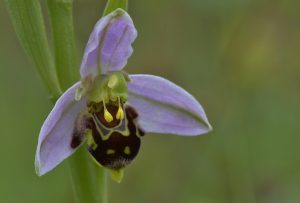We tend to think of grass as just grass. In fact there are some 150 different species of grass identified in the UK. Some are common and widespread, others are denizens of specialist environments such as mountains, moors and bogs, whilst a select few form the grasses that make up the ultimate man made specialist environments of amenity grassland, sports fields and grazing pastures. But for me one of the most fascinating facts about grass is that it didn`t really exist to any significant amounts until towards the end of the age of the dinosaurs. And really became widespread and ubiquitous across the world in the last 60 million years (along with the insects and animals that exploit them).
Grass diversity is important as many insects identify specific grass types as their egg laying plant of choice. So for example many of the hundreds of moth species are grass specialists. It is also an important food source for insects and larger animals both wild and domesticated. These tend to exhibit adaptations to cope with the silica in grass blades, which creates heavy wear on teeth and may also inhibit digestion. So creatures habitually grazing on grass have enlarged teeth (or mandibles) or constantly refresh their dentures. The other grass survival strategy involves fresh growth from it`s base so it can recover from heavy grazing (or mowing), fire and draught.
There are probably some 30-40 grasses found locally. Some are relatively straightforward to identify, once you get your eye in, such as Cocksfoot, False Oat Grass, Yellow Oat Grass (these first three are a major constituent of many country road verges), Perennial Ryegrass (a common constituent of man made grassland) plus Crested Dogstail, Meadow Foxtails, Sweet Vernal Grass, Quaking Grass and Yorkshire Fog. But others, such as the Meadow Grasses, Bents, Fescues, Hair Grasses and Bromes require an ID book, a hand lens, patience and paracetmol to pin down to a specific species.
But even if you don`t want to go that far, when walking through a grassland, don`t just look at the showy flowers, pay attention to the varied structures of the grasses, they are a key component of the complex web of bio-diversity that makes up the natural world.

